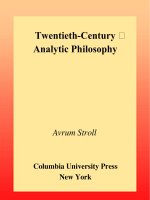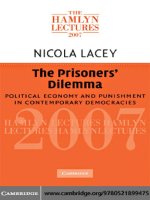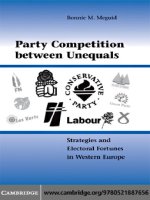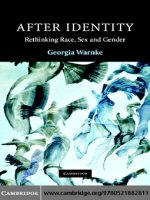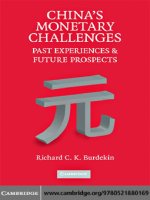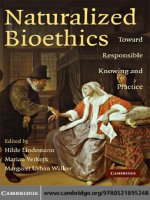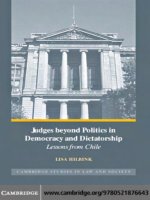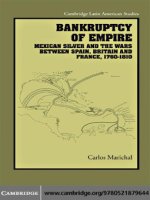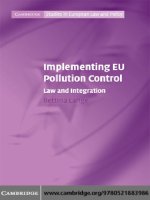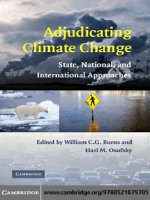0521832195 cambridge university press twentieth century english history variation and standardization dec 2006
Bạn đang xem bản rút gọn của tài liệu. Xem và tải ngay bản đầy đủ của tài liệu tại đây (1.85 MB, 262 trang )
This page intentionally left blank
Twentieth-Century English
Standard English has evolved and developed in many ways over the past
hundred years. From pronunciation to vocabulary to grammar, this concise survey clearly documents the recent history of standard English.
Drawing on large amounts of authentic corpus data, it shows how we
can track ongoing changes to the language, and demonstrates each of the
major developments that have taken place. As well as taking insights from
a vast body of literature, Christian Mair presents the results of his own
cutting-edge research, revealing some important changes which have not
been previously documented. He concludes by exploring how social and
cultural factors, such as the American influence on British English, have
affected standard English in recent times. Authoritative, informative, and
engaging, this book will be essential reading for anyone interested in
language change in progress - particularly those working on English, and
will be welcomed by students, researchers, and language teachers alike.
is Chair in English Linguistics at the Universita¨t
Freiburg, Germany, with research interests in the corpus-based description of modern English grammar, and in the study of regional variation
and ongoing changes in standard English worldwide. He is author of
Infinitival clauses in English: a study of syntax in discourse (Cambridge
University Press, 1990).
CHRISTIAN MAIR
STUDIES IN ENGLISH LANGUAGE
General editor : Merja Kyto¨ (Uppsala University)
Editorial Board : Bas Aarts (University College London), John Algeo
(University of Georgia), Susan Fitzmaurice (Northern Arizona
University), Richard Hogg (University of Manchester), Charles F. Meyer
(University of Massachusetts)
Twentieth-Century English
STUDIES IN ENGLISH LANGUAGE
The aim of this series is to provide a framework for original studies of English,
both present-day and past. All books are based securely on empirical research,
and represent theoretical and descriptive contributions to our knowledge of
national varieties of English, both written and spoken. The series covers a
broad range of topics and approaches, including syntax, phonology, grammar,
vocabulary, discourse, pragmatics, and sociolinguistics, and is aimed at an
international readership.
Already published in this series
Christian Mair Infinitival complement clauses in English: a study of syntax
in discourse
Charles F. Meyer Apposition on contemporary English
Jan Firbas Functional sentence perspective in written and spoken communication
Izchak M. Schlesinger Cognitive space and linguistic case
Katie Wales Personal pronouns in present-day English
Laura Wright The development of standard English, 1300–1800: theories,
descriptions, conflicts
Charles F. Meyer English Corpus Linguistics: theory and practice
Stephen J. Nagle and Sara L. Sanders (eds.) English in the Southern
United States
Anne Curzan Gender shifts in the history of English
Kingsley Bolton Chinese Englishes
Irma Taavitsainen and Pa¨ivi Pahta (eds.) Medical and scientific writing in Late
Medieval English
Elizabeth Gordon, Lyle Campbell, Jennifer Hay, Margaret Maclagan, Andrea
Sudbury and Peter Trudgill New Zealand English: its origins and
evolution
Raymond Hickey (ed.) Legacies of colonial English
Merja Kyto¨, Mats Ryde´n and Erik Smitterberg (eds.) Nineteenth century
English: stability and change
John Algeo British or American English? A handbook of word and grammar
patterns
Twentieth-Century English
History, Variation, and Standardization
CHRISTIAN MAIR
CAMBRIDGE UNIVERSITY PRESS
Cambridge, New York, Melbourne, Madrid, Cape Town, Singapore, São Paulo
Cambridge University Press
The Edinburgh Building, Cambridge CB2 8RU, UK
Published in the United States of America by Cambridge University Press, New York
www.cambridge.org
Information on this title: www.cambridge.org/9780521832199
© Christian Mair 2006
This publication is in copyright. Subject to statutory exception and to the provision of
relevant collective licensing agreements, no reproduction of any part may take place
without the written permission of Cambridge University Press.
First published in print format 2006
eBook (EBL)
ISBN-13 978-0-511-33397-2
ISBN-10 0-511-33397-8
eBook (EBL)
ISBN-13
ISBN-10
hardback
978-0-521-83219-9
hardback
0-521-83219-5
Cambridge University Press has no responsibility for the persistence or accuracy of urls
for external or third-party internet websites referred to in this publication, and does not
guarantee that any content on such websites is, or will remain, accurate or appropriate.
Contents
List of figures
List of tables
Acknowledgments
1
2
Setting the scene
page ix
xi
xv
1
Ongoing language change: problems of detection and
verification
2.1 “Visible” and “invisible” changes
2.2 The pitfalls of anecdotal observation
2.3 Documenting change
2.4 Outlook: a plea for methodological pluralism
12
12
15
21
33
3
Lexical change in twentieth-century English
3.1 Introduction
3.2 Case studies
3.3 Major trends
3.4 Neologizing in its social context
36
36
38
53
69
4
Grammatical changes in twentieth-century English
4.1 Introduction
4.2 Review of the literature
4.3 Aspect: twentieth-century changes in the structure
and use of the progressive
4.4 The going to-future
4.5 Modality: must and shall – two modals on the
way out, and possible replacements
4.6 Further developments in tense, aspect, modality:
a synopsis of current research
4.7 Current changes in the English voice system
4.8 Nonfinite verb forms: some twentieth-century
developments in the field of clausal complementation
82
82
84
88
95
100
108
111
119
vii
viii
Contents
4.9 Nouns, pronouns, adjectives
4.10 Conclusion
140
154
5
Pronunciation
5.1 Introduction
5.2 A history of RP in the twentieth century
5.3 “General American”: myth or reality?
156
156
162
173
6
Language change in context: changing communicative and
discourse norms in twentieth-century English
181
6.1 Introduction
181
6.2 The colloquialization of written English in the
twentieth century
183
6.3 Americanization?
193
6.4 Analysis of selected sample texts
195
Conclusion
200
Appendix 1 Brief survey of the corpora used for the
present study
206
Appendix 2 The OED Baseline Corpora
210
Appendix 3 Estimating text size in the newspaper
archives and the World Wide Web
213
Appendix 4 A quarterly update of the OED Online
(New Edition) – 13 March 2003: Motswana to mussy
217
References
Index
231
242
Figures
1.1 Languages of publication in five natural sciences
(1879–1980), (Tsunoda 1983)
2.1 Four matching one-million-word corpora of
written English
3.1 Frequency of use of selected computer neologisms in
The Guardian (and Observer) on CD-ROM
3.2 Frequency of use of selected military neologisms in
The Guardian (and Observer) on CD-ROM
3.3 March 2003 OED updates for words containing the
combining form multi3.4 March 2003 OED updates – out-of-sequence entries
3.5 Frequency of selected verbs of the up/down þ V type
in The Guardian (and Observer) on CD-ROM
3.6 Spread of three deverbal adjectives in The Guardian
(and Observer) on CD-ROM
4.1 Going to and gonna 1600–2000 – frequency as
n/10,000 citations
4.2 Get-passives according to age in the BNC
4.3 Nonfinite complements of remember in the
OED quotation base by century – normalized
frequency as n/10,000 quotations
4.4 Help þ infinitive 1600–2000 – frequency as n/10,000
quotations
4.5 Analytical and synthetic comparison for four classes of
adjectives (Kyto¨ and Romaine 1997: 344)
5.1 The decline of /oe/ (John Wells, source:
/>5.2 Major dialect areas in the US based on the Dictionary of
American regional English (DARE) (Carver 1987) and the
Phonological atlas of North America (Labov et al. 2006)
page 9
24
41
44
55
56
65
69
97
115
127
138
150
166
ix
x
List of figures
(source: />NationalMap/NationalMap.html)
5.3 Merger of the vowels in cot and caught (source: William
Labov, />ICSLP4.html#Heading2)
A3.1 Textual growth in The Guardian (and Observer)
on CD-ROM
A3.2 Deep breath in top-level Web domains, December 2002
to March 2003
178
180
215
216
Tables
1.1 Population of major urban centers in the English-using
world
1.2 Percentage of languages in natural science publications,
1980 to 1996
1.3 Percentage of languages used in publications in the
humanities, 1974 to 1995 (adapted from a graph in
Ammon 1998a: 167)
2.1 Prepositions following different in four corpora
2.2 Prepositions following different in regionally stratified
Web material (Google, 30 May 2004)
2.3 Proportion of on/upon in four corpora
2.4 Proportion of on/upon in three samples from the OED
quotation base
2.5 Lexical items most characteristic of four groups of
speakers in a corpus of spoken British English (compiled
from Rayson et al. 1997)
2.6 Frequency of wanna in the BNC per age group
(x/1,000,000 words)
3.1 Wicked – frequency in the spoken-demographic BNC per
million words by age group
3.2 Massive – frequency in the spoken-demographic BNC per
million words by age group
3.3 OED Online – new words first attested in the twentieth
century
3.4 Nineteenth- and twentieth-century borrowings from
Yiddish in the OED
3.5 Twentieth-century borrowings from Spanish first attested
in the OED
3.6 Proper nouns consisting entirely of capital letters:
comparison of frequency in LOB and F-LOB
page 8
10
10
26
27
28
29
30
32
48
49
58
60
62
62
xi
xii
List of tables
3.7 Prefixed verbs in up- and down- in the OED
(twentieth century) and the BNC (compiled from
information in Scheible 2005)
3.8 Up/down þ V in four corpora – types (tokens)
3.9 Ongoing in four corpora
3.10 On/off/in/out/up/down þ V þ ing in four corpora – survey
3.11 On/off/in/out/up/down þ V þ ing in four corpora – type/
token ratios
3.12 Discourse frequency of virtue(s), value(s), etc. in selected
twentieth-century corpora
4.1 Progressive forms in the press sections (A–C) of four
reference corpora
4.2 Been being and be being on the English-language Web
(Google, 23 July 2003)
4.3 Going to-futures in four corpora (examples from
direct speech in brackets)
4.4 Going to – manually post-edited output for four
quarter-centuries
4.5 Will/shall- and going to-futures in four spoken corpora
(percentages, adapted from Szmrecsanyi 2003: 303)
4.6 Going to- and will-futures in two age groups in the
spoken-demographic BNC (normalized frequencies/
words per million)
4.7 Use of the modal auxiliaries in four corpora
4.8 Shall-futures in four corpora
4.9 Have (got) to in four corpora (press texts, section
A–C only)
4.10 Have got to in four corpora
4.11 Have to in four corpora
4.12 Obligation and necessity in the Santa Barbara Corpus
of Spoken American English and the conversation
component of ICE-GB
4.13 Must and have to by function in ICE-GB (spoken),
adapted from Depraetere and Verhulst (forthcoming)
4.14 Get-passives in four corpora (examples from direct
speech in brackets)
4.15 Frequency indices for get-passives in the BNC
4.16 For þ NP þ to-infinitival clauses in four corpora
4.17 For þ NP þ to-infinitival clauses in three OED
Baseline Corpora
4.18 For þ NP þ to-infinitival clauses in three OED Baseline
Corpora and F-LOB and Frown (normalized, as
instances per million words)
64
64
66
67
67
78
90
92
96
98
98
99
101
102
104
104
104
105
105
113
116
124
124
125
List of tables
4.19 Gerunds and infinitives after remember in the OED
quotation base – normalized frequencies (“n/10,000
quotations,” rounded to the first decimal, absolute
frequencies in brackets)
4.20 Notional subjects in gerundial constructions after
remember in the OED quotation base
4.21 Proportion of infinitival and gerundial complements
after begin in four corpora
4.22 Infinitive vs. gerund complements with begin in selected
British databases
4.23 Infinitive vs. gerund complements with begin in selected
American databases
4.24 To-infinitive: V-ing after start in four corpora
4.25 Nonfinite complements of prevent in the OED
Baseline Corpus
4.26 Ratio of prevent NP from V-ing vs. prevent NP V-ing
in four corpora
4.27 Ratio of stop NP from V-ing vs. stop NP V-ing in
four corpora
4.28 Save NP V-ing in selected top-level Web domains
4.29 To- vs. bare infinitives with help in four corpora
4.30 Complementation of help in the “spoken-demographic”
BNC
4.31 Whom in four matching corpora
4.32 Nominative vs. objective case for pronouns in specific
syntactic contexts (BNC)
4.33 ’S-genitives in four tagged corpora
4.34 Use of genitive and of-phrase in the press sections (A–C)
of two corpora (compiled from Raab-Fischer 1995)
4.35 Normalized frequencies (occurrences per million words)
for selected genitives in spoken and written text types
from the BNC
4.36 Fewer vs. less with count nouns in selected corpora
5.1 Variably pronounced words in contemporary RP (John
Wells, Longman Pronunciation Survey)
6.1 Frequencies of say in selected genre categories of
four corpora
6.2 Verb and negative contractions in the four corpora
(from Leech and Smith 2005)
6.3 Contraction ratios (not-contractions) in journalistic and
academic prose
6.4 Decline in frequency of use of the be-passive in the four
reference corpora (from Leech and Smith 2005)
xiii
127
128
128
129
130
130
131
132
132
135
136
136
142
144
146
147
148
151
168
189
189
190
190
xiv
List of tables
6.5 Frequency of nounþcommon-noun combinations in
four corpora
A2.1 Composition of the OED Baseline Corpora
A2.2 The five most common words in Baseline, Brown,
LOB, Frown and F-LOB
A2.3 “Absolute frequencies (rank)” for selected function
words in five corpora
A3.1 Frequency of selected collocations in two corpora and
eight newspaper archival discs
A3.2 Frequencies of ten collocations in the BNC and
selected top-level Web domains
192
210
211
212
214
215
Acknowledgments
When I started working on the corpus-based investigation of change in progress in present-day English in the early 1990s, writing a book on this topic
soon began to seem an attractive idea, though one which was bound to remain
rather theoretical for a long time. Now that the book is about to be published,
I would like to take the opportunity to thank a number of organizations and
people without whose help it is unlikely that Twentieth-Century English would
have seen the light of day a mere fifteen years after the idea for the book was
first conceived.
To the Deutsche Forschungsgemeinschaft (DFG) I owe thanks for generously
supporting two corpus-related research projects from 1994 to 1996 and from
2003 to 2006. Without their funding, F-LOB and Frown, two corpora providing important evidence for the present study, would have been completed
much later (if at all), and various laborious but extremely useful annotation
schemes and other enhancements would not even have been attempted. If the
DFG gave the money, more members of my team at Freiburg than can be
named here have given their expertise and dedication over the years. If I single
out Marianne Hundt, Andrea Sand, Stefanie Rapp, Birgit Waibel, and Lars
Hinrichs by name, I hope that many others involved in the projects for longer
or shorter periods of time will not take this amiss.
At CUP, I would like to thank Kate Brett, who, after discussing the idea of a
history of twentieth-century English with me at the Edinburgh Late Modern
English conference in 1998, encouraged me to formalize it by submitting a
proposal to the Press. Helen Barton, who eventually took over from Kate, was
equally sympathetic and additionally showed welcome patience in the final
stages of completing the manuscript. Valuable suggestions for improvements
were made by Merja Kyto¨, one of the series editors, who carefully went
through the first version of the completed manuscript. At the very end of the
production process, working together with Nikky Twyman as a copy editor was
a pleasant and humbling experience, pleasant because of her quiet and goodhumored efficiency, and humbling because of the number of oversights she
spotted in a manuscript which I thought I had proofread carefully.
xv
xvi
Acknowledgments
I hope that the book will convey to its readers some of my own fascination
with the “living history” of English, its recent past, its rich and diversified
present, and its future, and that it will encourage others to keep researching the
many questions which I have had to leave unanswered.
Freiburg, February 2006
CM
1
Setting the scene
. . . ask yourself whether our language is complete; – whether it was so
before the symbolism of chemistry and the notation of the infinitesimal
calculus were incorporated in it; for these are, so to speak, suburbs of our
language. (And how many houses or streets does it take before a town
begins to be a town?) Our language can be seen as an ancient city: a maze
of little streets and squares, of old and new houses, and of houses with
additions from various periods; and this surrounded by a multitude of new
boroughs with straight regular streets and uniform houses.
(Ludwig Wittgenstein, Philosophische
Untersuchungen/Philosophical investigations,
translated by G. E. M. Anscombe. Oxford: Blackwell, 1967: 18)
Anyone proposing to write a history of the English language in the twentieth
century begs a number of questions, which it is necessary to answer at the very
outset of what might seem an excessively ambitious project.
Isn’t the topic too vast and complex for a single author to tackle? If one bears
in mind that in contrast to historians of Old and Middle English, who in
general suffer from a poverty of evidence, the historian of recent and contemporary English is deluged with data and, in principle, needs to write separate
histories of several richly documented standard and nonstandard varieties, and
a history of contact and influence among them, the answer to this question is
an obvious “yes.” The only justification that the present writer is able to offer
for undertaking the project against the odds is that he has narrowed the focus
from the very start to one highly codified variety, namely the written standard
which – in the twentieth century – was in use throughout the English-speaking
world with minor local differences in spelling, lexicon, idiom, and grammar.
The spoken usage of educated speakers in formal situations, which can be
considered the oral correlate of this written standard, will be considered where
relevant. While this restriction is problematical for many reasons, it is justifiable because of the social prominence of the standard in the present, and also
because most histories of English covering developments from the late Middle
English period onwards have – explicitly or implicitly – been histories of the
standard, too.
1
2
Twentieth-century English
What about the observer’s paradox? In a history of contemporary English,
this paradox takes two forms. First, it might be impossible for us to identify
and document recent and ongoing linguistic changes against the background
noise of synchronic regional, social, or stylistic variation that surrounds us
and in which these diachronic developments are embedded. Second, assuming
that we can identify ongoing language change, we will still have to ask the
question whether we can free ourselves from the social prejudices which have
normally caused ongoing changes to be viewed negatively – as instances of
erroneous or illogical usage or even as signs of decay or degeneration. As for
the first manifestation of the paradox (our ability or inability to even perceive
ongoing change), there is a long tradition of skepticism – exemplified, for
example, in a much-quoted statement in Bloomfield’s Language.1 The optimistic tradition, by contrast, is a much younger one, going back to William
Labov’s 1960s work on extrapolating diachronic trends from synchronic variation, and is still largely confined to sociolinguistic circles. As a descriptive
contribution to the history of English from around 1900 to the present, the
current study will not be able to settle the dispute between the optimists and
the pessimists in a principled way; rather, it has opted for a practical compromise by not concentrating on all aspects of linguistic change to the same
degree. Little emphasis will be placed on the often futile search for the first
authentic and/or unambiguous recorded instance of an innovation, or on
speculations about possible reanalyses, rule reorderings, or other adjustments
in speaker competence or the abstract system underlying the recorded data.
Rather, the focus will be on the spread of innovations through varieties, textual
genres, and styles, or on provable shifts in frequency of use in a defined period.
In other words, the present study aims to exploit the full potential of the
corpus-linguistic working environment that has become available to the student of English in recent decades – an environment which, in addition to
corpora in the narrow sense (that is, machine-readable collections of authentic
texts or natural discourse which have been compiled expressly for the use of
linguists), now includes important electronic dictionaries such as the continuously updated online version of the Oxford English dictionary (OED) and a vast
mass of digitized textual material not originally compiled for the purposes
of linguistic study.2
1
2
“The process of linguistic change has never been directly observed; we shall see that such
observation, with our present facilities, is inconceivable” (Bloomfield 1933: 347). In
Chapter 2 we shall see that Bloomfield’s position – categorically negative in this passage –
is modified elsewhere in his work and, more importantly, that there has been considerable
improvement in “our present facilities.”
The corpora consulted for the present study and the methods used for their analysis will
be discussed in the appropriate places, with a summary of the relevant information in
the Appendix. Readers interested in a more general introduction to the thriving field
of English corpus-linguistics are referred to introductory handbooks such as Biber et al.
(1998) or Meyer (2002).
Setting the scene 3
As hinted at above, the second manifestation of the observer’s paradox in
the study of ongoing linguistic change is the possible distorting influence of
the prescriptive tradition. This is a serious problem which needs to be acknowledged. Of course, it is unlikely that professional linguists will repeat the often
exaggerated and irrational value judgments on linguistic usage propagated by
this tradition. The effect the prescriptive tradition exerts on research on
current change is more subtle and indirect; it introduces a hidden bias into
the study of ongoing change by setting the agenda of topics worth the researcher’s attention. In this way, relatively minor points of usage and variation receive
an amount of attention completely out of proportion to their actual significance (even if the linguist’s intention may merely be to refute prescriptive
prejudice), while much more important and comprehensive changes go unnoticed. To give a few examples, the literature on grammatical change in
present-day English is rife with comment on the allegedly imminent disappearance of whom (a development for which there is very little documentary
evidence – see Chapter 4) or the use of hopefully as a sentence adverb (which
at least is a genuine twentieth-century innovation on the basis of the OED
evidence, with a first attestation for the year 1932). This is so because these two
points of usage have a high profile as linguistic markers in the community and
are much discussed by prescriptivists. Measured against the sum total of
ongoing changes in present-day English, however, both are mere trivia. Comprehensive and far-reaching developments, on the other hand, which affect the
very grammatical core of Modern English, such as the spread of gerunds into
functions previously reserved for infinitives, tend to go unnoticed because
these changes proceed below the level of conscious speaker awareness and
hence do not arouse prescriptive concerns. Again, the remedy here is the use
of corpora. Corpora make it possible to describe the spread of individual
innovations against the background of the always far greater and more comprehensive continuity in usage, and corpus-based studies of linguistic change
in progress are therefore likely to correct more alarmist perceptions based on
the unsystematic collection of examples or impressionistic observation, which
are inevitably biased towards the strange, bizarre, and unusual.
Is there sufficient previous work on the recent history of English to write a
survey such as the present one?
A mere twenty years ago, the answer to this question would have been in
the negative. Throughout the twentieth century there was never a dearth of
“state of the language” books aimed at the general educated public. Brander
Matthews, the American man of letters, published his Essays on English in
1921. J. Hubert Jagger’s English in the future, which – in contrast to what the
title suggests – is mostly about English in the present, appeared in 1940. More
recently, two collections of essays on the State of the language were edited by
Leonard Michaels and Christopher Ricks (Michaels and Ricks 1980, Ricks
1991). Most such works cover ongoing changes (whether perceived or real), but
they tend to do so only very superficially. A more reliable source of in-depth
4
Twentieth-century English
information on current change would thus seem to be the major scholarly
histories of the language. However, until recently these tended to peter out at
some point around 1800, leaving the history of English in the nineteenth and
twentieth centuries as largely uncharted territory.3
Over the last twenty years, however, the situation has definitely improved.
There has been a surge of interest in research on the recent history of English,
which has also resulted in several landmark publications offering at least
partial surveys. The recent history of English, with a strong (and, in the first
two cases, exclusive) emphasis on the nineteenth century, is dealt with in two
book-length studies (Bailey 1996, Go¨rlach 1999), and volume IV (“1776–
1997”) of the Cambridge history of the English language. In a broad sense,
the present book is a chronological continuation of Bailey’s and Go¨rlach’s
monographs – albeit with slightly different priorities. In comparison to Bailey
(1996), it will aim for a fuller coverage of the structural history of the language
(particularly the grammar), whereas in comparison to Go¨rlach the two major
differences are that the treatment is not restricted to England exclusively and
that, in compensation for the widening of the geographical scope, less emphasis
will be placed on the didactic presentation and annotation of source texts.
The most important point of reference for most chapters, though, will be
volume IV (“1776–1997”) of the Cambridge history. As will become clear, this
work’s treatment of nineteenth-century developments is admirable and provides a good foundation for the present study. Its coverage of the twentieth
century, on the other hand, is less complete and will be expanded here.
More problematical sources than these scholarly linguistic works are the
many popular works on the recent history of English and the state of the
language. For one thing, the number of such publications is vast – from books
written by non-linguists for lay audiences (e.g., Michaels and Ricks 1980, Ricks
1991, or Howard 1984) to works such as Barber (1964) or Potter (1969 [1975]),
which are valuable as provisional surveys of the field by experts. Many of these
“state of the language” books are informed by a spirit of traditional prescriptivism and/or cultural pessimism or more concerned with the ideological and
political aspects of language standardization than the linguistic facts themselves. But even a work such as Barber’s (1964) excellent survey of “linguistic
change in present-day English” needs to be treated with some caution. The
insights and claims it contains are generally based on the author’s anecdotal
observations and unsystematic collection of examples, which – as will be shown
in Chapter 2 – is a notoriously unreliable methodology in the documentation of
ongoing changes.
3
This is partly a matter of author interest, which gave priority to earlier developments, and
partly a result of publication date, as classic works such as Jespersen (1909–1949) have
not really been challenged or even equaled in comprehensiveness of coverage and authoritativeness until recently.
Setting the scene 5
Among all the relevant publications, the one closest in spirit to the present
book probably is Bauer (1994), as this work emphasizes the use of corpora and
empirical documentation in the study of ongoing change. It is not to deny the
merit of Bauer’s pioneering effort to point out that it is comprehensive neither
in its coverage of the phenomena nor in its use of the available corpora and
textual resources, thus leaving many important topics for the present study
and others to explore.
Methodologically sound work on individual instances of change in progress
is, of course, abundant in the sociolinguistic literature. Again, however, the
overlap with the present study is minimal, as it will focus on the one variety of
English which has been largely neglected in sociolinguistics, namely standard
English, in its spoken and written forms. Furthermore, the study of phonetic
change, which is usually the most prominent topic in sociolinguistic analyses
of change in progress, is not the priority in the present book, whereas lexical
and grammatical change, which are studied in detail here, play a lesser role
in the sociolinguistic literature.
In sum, there is, thus, clearly room for a project such as the present one:
a concise and comprehensive history of standard English in the twentieth
century, written by one author in a single volume.
As we shall see, standard varieties of languages differ from others in that
they combine spontaneous historical evolution with elements of conscious
planning. As Milroy and Milroy (1991) have shown, standardization, the
suppression of optional variability in language, is as much of an ideological as
a linguistic phenomenon. This means that a history of standard English is,
ultimately, part of the cultural and intellectual history of the English-speaking
peoples. It is, of course, extremely risky to make generalizations about cultural
and social developments over a whole century and a huge community of
speakers, but there are some trends which are immediately relevant to the
history of standard English. For the post-World War II United States, Baron
has identified the following trends:
–
–
–
reduced emphasis on social stratification and on overt attention to upward
mobility
notable disconnects between educational accomplishment and financial
success
strong emphasis on youth culture (Baron 2003: 90).
Similar trends have been in operation in most English-speaking societies
in the industrialized world, and it is easy to see how all of them have worked
against narrow and elitist definitions of the standard. Some of the ways in
which these trends have affected the shape of standard English today will be
studied in greater depth in Chapter 6.
In the introduction, it will be sufficient to sketch briefly the social and
cultural context of standard English in 1900 (the point at which the present
history opens) and compare it to the situation in 2000.
6
Twentieth-century English
In many fundamental regards, there was no change at all. Standard English,
in 1900 as well as in 2000, was a fully mature written standard, displaying all
the pertinent metalinguistic infrastructure of dictionaries, usage books, grammars, and other linguistic reference materials. Pedagogical materials were
available for those wishing to learn English as a foreign language at both points
in time, and 1900 as well as 2000 saw a flourishing tradition of social commentary and debate on linguistic issues. It is, indeed, even surprising to see
that – with the exception of language regulation in the spirit of “political
correctness,” of which there was very little in 1900 – even many of the topics
and issues have remained the same. The use of ain’t or double negatives was
proscribed in formal writing and educated speech then as now; the word booze
was a mildly offensive slang term hovering on the edge of respectability in
1900 and in 2000; and then as now the educated guardians of the language
tended to argue about where to put the stress in polysyllabic words of Latin
and French origin such as controversy or comparable.
There is continuity also in the geography of English. The hold of English on
West Africa and the Asian subcontinent may have been more tenuous, restricted to small elites, in 1900 than it is now, despite the fact that these
territories were under direct British rule in the days of the Empire. Purely in
terms of geographical spread, however, English was a global language in 1900
as much as in 2000, with the language being the dominant one in the British
Isles, North America, Australia, and New Zealand, and having established
itself firmly in smaller communities throughout the rest of the globe.
However, important changes loom beneath this veneer of stability. The
technologization of the spoken word was still in its beginnings in the
nineteenth century. Radio, talking pictures, and television all profoundly
changed the everyday life of the ordinary citizen in the twentieth century and
had a profound impact on the norms of spoken usage. Sometimes, technology
serves to support pre-existing trends towards an establishment and spread of a
spoken standard – as was the case with the BBC championing “Received
Pronunciation” in Britain and internationally in the 1920s and 1930s. More
informal but no less successful standardization efforts were made by the national
broadcasting networks in the United States (Bonfiglio 2002). At other times,
technology subverted the authority of such standard norms by ensuring
worldwide exposure to nonstandard speech – from the Beatles-inspired boom
of northern English working-class accents in the 1960s to the global spread of
stylized African-American vernacular English through rap and hip-hop music.
The most recent technology-driven transformation of English has, of course,
taken place in the course of the digital revolution and the rise of computermediated communication, which has infused into written English some of the
spontaneity, informality, and immediacy of speech (Crystal 2001).
Progress was made in the course of the twentieth century also in the
recognition of the pluricentricity of English. In 1900, London, or the English
upper and upper middle classes, had already ceased to be the exclusive source
Setting the scene 7
of linguistic prestige in the English-speaking world, even though this fact
tended to be acknowledged in the United States rather than Britain at the
time. By the end of World War I, there was widespread consensus that
standard English came in two distinct but equal varieties – British (or English)
and North American. Decolonisation started slowly with the establishment of
internal self-government in the European-dominated “settler” colonies at
various points of time in the early twentieth century and speeded up dramatically after World War II. In 1910, the British Empire was at the peak of its
power, with direct control over a quarter of the earth’s land surface and more
than a quarter of its population. In 2000, three years after the return of Hong
Kong, the last economically and demographically significant colony, to China,
what was left of the Empire comprised around twenty minute and often
isolated territories mostly in the Caribbean and the Atlantic and Indian Oceans,
namely – in alphabetical order – Anguilla, Ascension Island, Bermuda, the
British Antarctic Territory, the British Indian Ocean Territory, the British
Virgin Islands, the Caymans, the Falklands, Gibraltar, Montserrat, Pitcairn
(with Ducie, Henderson and Oeno), South Georgia and the South Solomon
Islands, the Turks and Caicos, Tristan da Cunha, and St. Helena.
Not surprisingly, such far-reaching political developments were bound to
have linguistic consequences. With a time-lag of about a century after political
self-government, a degree of autonomy similar to that accorded to American
and British English has now been attained by the Southern Hemisphere settler
Englishes which have developed in Australia, New Zealand, and among
the English-speaking community in South Africa. Australian English has even
become an internationally relevant norm in language teaching especially in the
South Pacific. This path of development from colonial dependence to growing
autonomy is likely to be followed eventually by the Creole-influenced Englishes of the Caribbean, a region where norms of educated usage are now
emerging in a three-way competition among a still powerful traditional British
model, the currently dominant American norm, and local usage.
In principle, there is no reason why official or second-language varieties
with a long history of institutionalization such as those found in West Africa or
India should not be placed alongside these natively spoken varieties as legitimate new standards of English. In practice, the full recognition of these varieties
is hindered by a feeling of linguistic insecurity among their own speakers
and negative attitudes held by native-speaking outsiders. Speakers of these
post-colonial non-native Englishes are often caught in a double bind. A tooperfect approximation to the former colonial norm is socially undesirable,
especially in pronunciation, but many of the stable phonetic and grammatical
features that have emerged still tend to be seen as interference-caused errors
rather than potential harbingers of a new and legitimate local norm of English
usage. In such a situation, rather than try and determine how many standard
varieties of English there are – a pointless exercise unless one is willing to
take on the Herculean task of investigating speakers’ evaluation of their own
